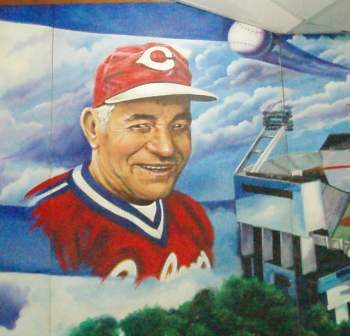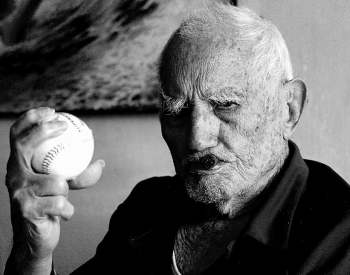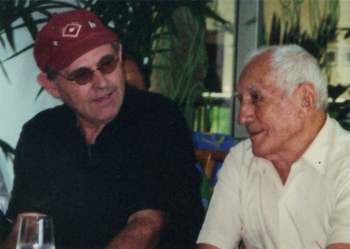Cuba’s & World’s Oldest Ballplayer Celebrates 100th
By Peter C. Bjarkman

HAVANA TIMES, April 9 — April 2011 has been the most historic of months in the baseball-loving nation of Cuba. An upset-filled post-season tournament has added a final exclamation point to a thrill-packed and record-filled Golden Anniversary edition of the island’s National Series championships. But if symbolic “gold” attached to a five-decade milestone season has provided the headline story for the bulk of the current Cuban baseball campaign, another equally remarkable threshold is about to coincide with this year’s grand finale in the world of Cuban baseball.
On April 25 – only a couple days before or after the final post-season pitches have been tossed – island legend Conrado Marrero will be celebrating his historic one hundredth birthday. On that date the former Washington Senators hurler – already Cuba’s only surviving pre-revolution major leaguer, as well as the oldest living MLB alumnus – will also become major league baseball’s only currently existing centenarian.
Only fifteen alumni major leaguers have ever crossed the century mark, the most recent and last surviving member of that exclusive club being former Brooklyn Dodgers “cup-of-coffee” infielder Tony Malinosky who appeared in only thirty-five 1937 National League games and logged only 79 official big league at-bats. Malinosky reached the century mark back in October 2009 and his death this February (less than two months before the Cuban’s own centennial) left Marrero as the most senior former pro ballplayer.
It is a transitory distinction that will likely last a while, since Marrero himself gives every indication of hanging around for at least another spring or two, and also since the next in line for such an honor – Ace Parker, former pro football star of the 1930s and also a two-season part-timer with Connie Mack’s American League Philadelphia Athletics – is not scheduled to cross the threshold until May 2012.
Sadly enough, Connie Marrero’s special anniversary date will most likely pass all but unnoticed among North American fans and scholars. It is also almost certain to draw little if any official (or even “unofficial”) notice from the major league baseball establishment. For one thing, the big league club currently residing in Washington (a National League franchise transplanted from Montreal) is not even the one Marrero suited up for 60 seasons back; Marrero’s early-1950s American League Washington Senators were long ago morphed into a current Minnesota Twins outfit that has never held much interest in celebrating its historic roots in the nation’s capital. And for another thing, MLB and its corporate television partners are seemingly enamored of ballpark nostalgia only when there are tickets and merchandise to be marketed or broadcast ratings to be hiked – witness the recent annual celebrations of Jackie Robinson’s role in MLB integration (a crafty spin placed on what in reality remains the sport’s biggest historical black mark), or the heavy aura of World Series “tradition” now artful attached to media coverage of an altogether “untraditional” marathon big-league post-season championship tournament.

However there is little seeming profit in acknowledging an obscure corner of the sport’s legacy – especially when the subject of that legacy lives “behind enemy lines” in a country that has proudly and steadfastly kept its own national pastime at full arm’s length from any financial dealings with corporate professional baseball. Such is the sad legacy of decades of strained American and Cuban relations.
But if Cuba’s centenarian ballplayer hero has largely fallen off the radar for North American fandom as well as for MLB officialdom his stature in his homeland remains undiminished. Each year for the past half-decade or more the Cuban Baseball Federation has celebrated an “official” Marrero birthday gathering in Havana’s venerable Latin American Stadium (itself dating back to 1946), a festive event the increasingly feeble but nonetheless remarkably cogent ex-pitcher has frequently attended.
Marrero’s actual birth date was for years incorrectly reported (often as May 1, 1915) in most North American baseball encyclopedias and by most U.S.-based websites devoted to big-league data and statistics. Marrero’s official Cuban passport (a copy of which was provided to this author by grandson Rogelio, when I was preparing a detail biographical essay last spring) nonetheless carries the April 25, 1911 birth date and that date is the one consequently sanctioned for all official Marrero birthday celebrations on the island.
This year Cuban baseball’s governing body went one better when it dedicated its Golden Anniversary Season league all-star game to the former big leaguer. That mid-season contest was celebrated in early February at Fifth of September Stadium in Cienfuegos, the same coastal city in which Marrero in 1938 had launched his fabulous pitching career in the pre-revolution Cuban amateur league at the already surprisingly advanced age of twenty-seven.
Last public appearance
Marrero’s last notable public appearance outside of the annual Havana birthday gatherings came a dozen years ago when he tossed several ceremonial first pitches toward Orioles leadoff slugger Brady Anderson at the historic May 1999 Baltimore versus Team Cuba exhibition game in Latin American Stadium. That was the last time that most stateside fans might have caught a glimpse the Cuban legend, courtesy of an ERSPN telecast of the landmark Havana contest. But Marrero has not been entirely invisible to a current generation of North American ball fans, thanks to the efforts of Canadian baseball enthusiast Kit Krieger. Vancouver-based Krieger has made the aging icon’s tiny third-floor Havana dwelling a regular stop for his popular “Cubaball” tours that have regularly visited the island each spring for more than a decade.

Krieger first befriended Conrado Marrero and his guardian grandson Rogelio during the first Cubaball trek to Havana back in 2001 and over the subsequent decade Krieger has made it something of a personal crusade to find financial support for the Marrero family, struggling to survive in a sagging Cuban economy brought on in large part by a continued and controversial U.S. island-wide blockade. It has also been Krieger’s mission over the years to keep the one-time star’s memory and accomplishments alive for North American fans and to re-establish contacts for Conrado with many of his still-living one-time big-league rivals and former teammates.
Less than a month ago Krieger once again brought his group of two-dozen-odd American and Canadian touring baseball fans (this writer included) to visit with Marrero a mere day after the aforementioned All-Star Game ceremonies honoring Conrado in Cienfuegos. This time Krieger had brought approximately twenty hand-written cards and letters containing heart-felt birthday wishes from some notable big leaguers (including Roy Sievers, Ned Garver, J.W. Porter, and Harmon Killebrew) who had played with or against the Cuban during his Washington American League days. Marrero has been blind for several years and can no longer leave his grandson’s apartment.
But his steel-trap mind (the one that once catalogued every weakness of rival batters) is as sharp as ever and he astounded the Cubaball group when he responded to Krieger’s readings of the various greeting from fellow big leaguers by recalling and expounding on exact scenarios and moments from games played more than six decades in the past. Connie also reported that he was indeed following this season’s National Series via daily radio play-by-play broadcasts and he was quick enough to offer his insightful critiques on the strengths and weakness of some of today’s top island league players.
Marrero Helped Train Alfredo Despaigne
Of various anecdotes with which Marrero entertained his spellbound audience of foreign fans on that recent February afternoon, none was more intriguing perhaps that his comments concerning current league and national team home run champion Alfredo Despaigne. When asked about Cuba’s best current talent Conrado was quick to put Despaigne at the top of his list. He then began to elaborate on how he had once helped to train the young slugger by spending afternoons tossing countless batting practice pitches to the then-13-year-old youngster on a sandlot field in Granma Province.
Marrero had indeed served as a part-time pitching instructor for the Granma club when well into his late eighties. Since Despaigne will not turn 25 until this coming June, the practice sessions Marrero was reporting must have taken place sometime in 1999, the same year Marrero took the mound to open the Baltimore Orioles exhibition and insisted on tossing not one but several impressive 90-foot heaves in the direction of Brady Anderson. The tale becomes truly remarkable, though hardly questionable, when one does the simply calculations and discovers that Conrado Marrero was already 88 years old and none the less still quite robust when he tossed ceremonial pitches at Brady Anderson and practice pitches to Alfredo Despaigne.

The Alfredo Despaigne tale provides another remarkable facet of Marrero’s incredible baseball legacy – his linkage to eight separate decades of Cuban baseball lore. As a youngster Marrero witnessed in person the pitching feats of Martin Dihigo, Cuba’s greatest blackball legend of the decades between the two world wars.
In the 1930s he built his own undying legend as the best pitcher in the Cuban amateur league, a circuit that was (as acknowledged by all serious historians of Cuban baseball) superior to the four-team Havana-based pro circuit of the time. In the early and mid-forties Marrero was next the ace pitcher of the Cuban national teams that dominated the earliest decade of amateur world series baseball competitions (an event today known as the Baseball World Cup).
After suspension from amateur play (for illegally performing for a pair of league clubs at the same time) Marrero reluctantly turned pro in the mid-forties and enjoyed three remarkable debut campaigns (at age 35-38) with the Havana Cubans of the B-level Florida International League, posting a 70-25 won-lost mark and eye-popping ERA totals of 1.66, 1.67 and 1.53.
Entering the big-time in 1950 as a 39-year-old rookie, the pint-sized cigar-chopping and junk-balling righty quickly established a reputation as one of the most colorful figures of major league baseball’s mid-century Golden Decade. He was also an effective enough starter in 1951 to pace an anemic Washington Senators staff with a team-high eleven victories.
Marrero’s winter-season Cuban League pro career didn’t wind down until 1955 (at age 44) and two summers later he was still hurling a few effective innings for the Havana-based AAA-level Cuban Sugar Kings. Electing to remain on the island after the social upheaval of the 1959 revolution, Conrado Marrero spent nearly a half-century training pitchers for the new-style Cuban amateur baseball and also for the increasingly powerful Cuban national team. As late as his ninth decade of life he was still actively playing a role in the training of a youngster (Alfredo Despaigne) who was destined to become one of the island’s top stars of the new millennium.
Is it not entirely appropriate, then – if not also remarkably ironic – that a memorable Golden Anniversary season of revolutionary Cuban baseball should overlap so precisely with the centennial celebration that has now made Conrado Marrero not only major league baseball’s oldest alumnus but also its sole remaining centenarian? No island baseball figure so perfectly spans and effectively unites the two distinct half-century-long eras of pre- and post-revolution Cuban baseball; no one else epitomizes so precisely the remarkable accomplishments of both professional and amateur baseball legacies in Cuba. If there is any downside to the Marrero saga it is the fact that MLB long ago turned its back on Conrado Marrero.
The near-heroic efforts of Kit Krieger across the past decade to obtain some small stipend from the Baseball Assistance Team (an MLB-affiliated organization established in 1986 with a goal of aiding “members of the baseball family who have come on hard times and are in need of assistance”) have repeatedly fallen on stone-deaf ears. One B.A.T. official reputedly dismissed Krieger’s efforts with the response that “Marrero has made his bed (by choosing to remain with his family in his homeland) and now he can lie in it.” Such is the distasteful political divide that alienates two nations sharing a common national pastime.
But if Marrero is still shunned for his patriotism by some of his fellow big-league alumni, he has never fallen between the cracks in his homeland, a land where baseball remains more sport than business and more national passion than commercial enterprise. It has often been alleged by those who do not fully understand the world of Cuban baseball that with its revamping of the island pastime after the 1959 social revolution, and with the 1962 founding of the amateur-style National Series, the government-based Cuban baseball establishment obliterated all ties with an earlier professional legacy. Marrero’s continued stature in his homeland – underscored by last month’s All-Star Game dedication and this month’s centennial Marrero celebrations – all demonstrate quite emphatically that nothing could be much farther from the truth.
Peter C. Bjarkman is author of A History of Cuban Baseball, 1864-2006 (McFarland, 2007) and is widely recognized as a leading authority on Cuban baseball, both past and present. He has reported on Cuban League action and the Cuban national team for www.BaseballdeCuba.com during the past four years and has authored “The Baseball Biography Project” essay on Conrado Marrero available from the Society for American Baseball Research at http://bioproj.sabr.org/.





